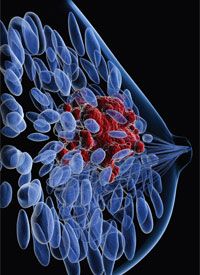CYP2D6 Genotype Linked With Suboptimal Outcomes in Breast Cancer
Patients with breast cancer who are ultrarapid or poor CYP2D6 metabolizers of tamoxifen have a worse prognosis compared with normal metabolizers after receiving a standard dose of the drug, due, in part, to a higher incidence of treatment-related adverse events.
breast cancer

Patients with breast cancer who are ultrarapid or poor CYP2D6 metabolizers of tamoxifen have a worse prognosis compared with normal metabolizers after receiving a standard dose of the drug, due, in part, to a higher incidence of treatment-related adverse events, according to results from a study published in the Journal of Clinical Oncology.
The 6-month discontinuation rates of tamoxifen among poor, intermediate, normal, and ultrarapid metabolizers were 7.1%, 7.6%, 6.7% (95% CI, 5.0-8.9), and 18.8% (95% CI, 10.2-32.9), respectively. Ultrarapid CYP2D6 metabolizers were more likely to discontinue tamoxifen within 6 months of receiving it compared with normal metabolizers (HR at month 6, 2.06; 95% CI, 1.11-3.82), but not afterward.
Additionally, a U-shaped association was found between CYP2D6 metabolizer status and breast cancer-specific mortality among poor (HR, 2.59; 95% CI, 1.01-6.67), intermediate (HR, 1.48; 95% CI, 0.72-3.05), normal (HR, 1.00), and ultrarapid (HR, 4.52; 95% CI, 1.42-14.37) metabolizers.
“Our study shows that patients with breast cancer with ultrarapid CYP2D6 metabolism were more likely to have strong tamoxifen-related symptoms, high tamoxifen discontinuation, and thus, worse tamoxifen treatment outcomes,” lead study author, Wei He, PhD, a postdoctoral researcher and assistant professor in the Department of Medical Epidemiology and Biostatistics at Karolinska Institutet in Stockholm, Sweden, in an interview with said OncLive.
The 2018 Clinical Pharmacogenetics Implementation Consortium Guideline for CYP2D6 and Tamoxifen Therapy strongly recommends the use of a standard dose of tamoxifen in patients with ultrarapid CYP2D6 metabolism. However, the recommendation is hypothesis-based, rather than evidence-based, according to He.
“Our results highlight the need to revisit the current CYP2D6 guideline for tamoxifen treatment,” said He.
In the prospective-retrospective study, investigators compiled data from a clinical breast cancer register, the Swedish Prescribed Drug Register, and self-reported questionnaires. Investigators genotyped CYP2D6 in 1309 patients who were diagnosed with stage I to III breast cancer between 2005 and 2012 and were treated with tamoxifen.
Investigators genotyped the most common CYP2D6 alleles (2, 2A, 3, 4, 6, 7, 8, 9, 10, 14, 17, 29, 35, 41A) to maximize the predictive value of the polymerase chain reaction—based assay that was used to categorize patients. A score was assigned to each allele, the sum of which determined whether patients were poor (activity score = 0), intermediate (activity score = 0.5 or 1.0), normal (activity score = 1.5 or 2.0), or ultrarapid (activity score >2.0) CYP2D6 metabolizers.
Baseline and tumor characteristics were well balanced between CYP2D6 metabolizer status groups. The median age at diagnosis was 58.1 years (range, 25.2-88.7) and the median follow-up was 10.4 years (range 1.1-13.4).
Ultrarapid CYP2D6 metabolizers were significantly more likely to use symptom-relieving drugs, such as antinauseants (P <.001), anxiolytics (P = .02), hot flash medications (P <.001), and analgesics (P = .22) within 3 months of starting tamoxifen versus normal metabolizers. This translated to a higher 90-day discontinuation rate among ultrarapid CYP2D6 metabolizers versus normal CYP2D6 metabolizers (P =.002). No significant difference was observed in the use of symptom-relieving drugs or tamoxifen discontinuation between poor or intermediate metabolizers versus normal metabolizers.
“If our results can be replicated by others, CYP2D6 should be evaluated [in clinical practice],” said He, who added that the next phase of this research is to evaluate whether patients with breast cancer who are ultrarapid CYP2D6 metabolizers will have better outcomes with aromatase inhibitors compared with tamoxifen.
He W, Grassmann F, Eriksson M, et al. CYP2D6 genotype predicts tamoxifen discontinuation and prognosis in patients with breast cancer. J Clin Oncol. 2020;38(6):548-557. doi: 10.1200/JCO.19.01535



